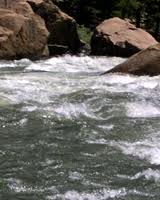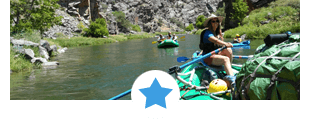The International River Grading System: How To Know A Rivers Rating
 Colorado river rafting can be hazardous at times and should not be taken lightly. But it can also be as harmless as a whimsical lazy river. It all depends on the ranking of the river, and more importantly, the ranking of certain rapids. Rafting the Royal Gorge for example, can have very mellow sections when little attention has to be paid. But around a corner there can be an explosive series of rapids where only the most skilled guides should be making an attempt at it.
Colorado river rafting can be hazardous at times and should not be taken lightly. But it can also be as harmless as a whimsical lazy river. It all depends on the ranking of the river, and more importantly, the ranking of certain rapids. Rafting the Royal Gorge for example, can have very mellow sections when little attention has to be paid. But around a corner there can be an explosive series of rapids where only the most skilled guides should be making an attempt at it.
Just as a snowflake, no two rivers are the same. Each is unique and has it’s own individual dynamic, which makes it like no other on earth. These rivers even change over time, so no river is the same as it has been, it gradually changes year after year. This means that every new attempt at a river should require new scouting to ensure it’s known which obstacles to avoid and which routes to take. The actual act of rafting is only part of the fun, figuring out a course and navigating is enjoyable in it’s own right. Especially when you make the right calls and decisions safely guiding your raft down the rapids.
The first thing that should be done prior to actually rafting, is seeing what previous rafters have said about the river. We wouldn’t have the majority of the things we have in this world if we couldn’t build off the success of others before us. With that said, a system has been developed which allows rafters to let other rafters know what they think about certain rivers. This system is known as The International River Grading System.
The International River Grading System
Grade I: Easy Rivers that are flat with slow moving water and the occasional small or simple rapid. Any waves present are low, with obstacles being obvious and easy to maneuver around. There is no technical training required to raft these rivers.
Grade II: Novice Rivers that frequently have rapids which are moderately sized with small and simple waves and eddies. Scouting is unnecessary as the river will be moving slow enough to avoid any obstacles that arise. Little training is required, mainly just understanding how to maneuver a raft.
Grade III: Intermediate For a rafter with some training and proficiency, these rivers are easily navigated. There will be a few routes that must be run correctly to avoid major obstacles and obstructions. There will be a number of rapids that have abnormal and irregular waves. There may even be a series of steps with a steep gradient that must be done. For the less experienced rafters, viewing a route from the saftey of the bank is advised.
Grade IV: Advanced These rivers are considered to be very challenging, with long stretches of rapids with irregular waves. The courses to take on these rivers will complicated and various obstacles and obstructions may be hidden and unseen underneath the waves. These rivers will also have waterfalls ranging up to 3 meters in height. There can be narrow and steep channels that are difficult to navigate. Regardless of the experience of the rafter, you will want to scout ahead to mark your path. These rivers require a group to be skilled enough to make a rescue if need be.
Grade V: Expert These rivers have all the same issues as grade IV does, however it is going to be more extreme. Meaning the waves are larger, drops steeper, and rapids more violent and less predictable. The routes to take for these are extremely difficult to manage, even when the exact course is known. There is a greater amount of risk involved in rafting these rivers.
Grade VI: Unraftable Some consider rafting on a class VI river suicidal, and only extreme luck or skill will allow you through)
Hopefully this guide has helped to explain the differences in river difficulties. Always be sure before you raft on a whitewater river that you understand what you are getting into. Before taking on stretches of river, always scout ahead to make sure you know what course to take. Even if you’ve done the river countless times before, new obstacles could have been created which weren’t there the time before. If you would care to perhaps do some Colorado rafting yourself, you should contact the people at Wilderness Aware Rafting to see what trip options are available this season.


